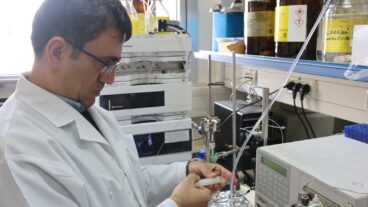The SHL monitoring center in Tel Aviv. ‘We have customers who are transmitting their ECG from any part of the world you can imagine’ – SHL’s Erez Alroy.Israeli scientists have developed a portable electrocardiograph machine that can transmit highly detailed data on heart activity to physicians by mobile phone.
The CardioSen’C is considered an advance in portable heart-monitoring devices because it uses many more electrodes to measure heart activity and is equipped to communicate the results instantaneously to a cardiologist.
SHL, the Israeli company behind the CardioSen’C, says its machine can dramatically reduce deaths from heart attacks through early diagnosis of patients who might otherwise hesitate before calling a doctor or rushing to a hospital to be monitored.
This is how it works: Patients attach 12 electrodes to their chest and upper body and strap the battery-powered unit on the front of their chest. Automatic digital transmission allows the electrocardiograph, or ECG, results to be transmitted at the highest-quality available and at a high speed to the patient’s cardiologist for instant diagnosis.
The machine is so small that readings can be taken anywhere, even while traveling. The unit is automatically connected via digital cell phone to a dedicated medical control center.
The company has also developed a system called “double transmission monitoring,” which allows the control center to direct the operation of the electrocardiograph and the transmission and download of data by remote control while medical staff talk to the patient.
Patients who suffer from heart disease, are recovering from bypass treatment or simply feel they are at risk are now in a position to measure their heart activity.
According to a report in the March issue of the journal Emergency Medical Services, coronary heart disease causes about 1.5 million Americans to suffer acute myocardial infarctions – or heart attacks – every year, resulting in about 500,000 deaths. Nearly half die before reaching a hospital.
The CardioSen’C can diagnose arrhythmia, ischemia and myocardial infarction.
Erez Alroy, co-chief executive officer of SHL, which specializes in telemedicine technology, said patients who don’t feel well can use the machine to measure their heart activity and consult instantaneously with physicians reading the data in real time.
“When people don’t feel well, it can take time to make the decision to go to a physician or a clinic. Maybe they put it off until the next day. This is a crucial time, when there can be irreversible damage to the heart,” said Alroy.
Heart patients who until now have been scared to travel for fear of being too far away from a doctor or clinic to measure their condition can now test themselves and be in immediate contact with an expert who speaks their own language.
“We have customers who are transmitting their ECG from any part of the world you can imagine,” said Alroy. “Most people hesitate before going to a local doctor abroad. They are worried about problems with the language, about the lack of medical history. We find that people prefer to call… back home, where they can speak their own language and then take instructions. People on holiday find it a very useful tool.”
Alroy said the unit would make taking an ECG no more trouble than taking your temperature. “We believe in the future more and more people will have various medical measuring devices at home,” he said.
SHL plans to market the CardioSen’C first in Israel, where the company already has more than 70,000 cardiac patient subscribers, and then in Europe. The company plans to market the unit later in the United States, where it is expected to cost several hundred dollars.
The company’s first ECG machine developed for patient use has already been approved for use in the United States. Its CardioBeeper 12/12 is a handheld ECG transmitter capable of sending a full ECG reading to the monitor center in 12 seconds via a standard phone line. The company has also developed a simple pin-prick blood test that can determine in seconds whether a patient has suffered a heart attack.
Mobile ECG machines that transmit data by phone to physicians are already available in the United States, but SHL said the CardioSen’C has several advantages over the existing services.
One of the competitors to SHL is CardioNet Inc., whose Mobile Cardiac Outpatient Telemetry unit is designed for use at home by patients and is already operating in more than 25 states.
The CardioNet unit consists of a sensor, monitor and base. Patients wear three leads attached to a lightweight sensor worn on a neck strap or belt clip that continuously transmit two channels of ECG data to the monitor.
The information is transmitted by wireless to the base unit, which transfers the data by landline or cell phone to the CardioNet Monitoring Center for review by a certified monitoring technician.
Irit Alroy, chief technology officer at SHL, said that while both devices collect ECG data and use cellular technology to transfer the information, SHL’s “CardioSen’C is a 12-lead ECG, similar to machines found in hospitals. There is a significant medical difference between a 12-lead ECG and a two- or three-lead ECG. (The 12-lead ECG can) diagnose many more types of cardiac events, in fact any condition that can be diagnosed by a full ECG in a hospital. Also, the cell-phone technology in the CardioSen’C is in a chip embedded in the device. It does not require an additional monitor and a base unit.”
(Reprinted with permission of the author)












